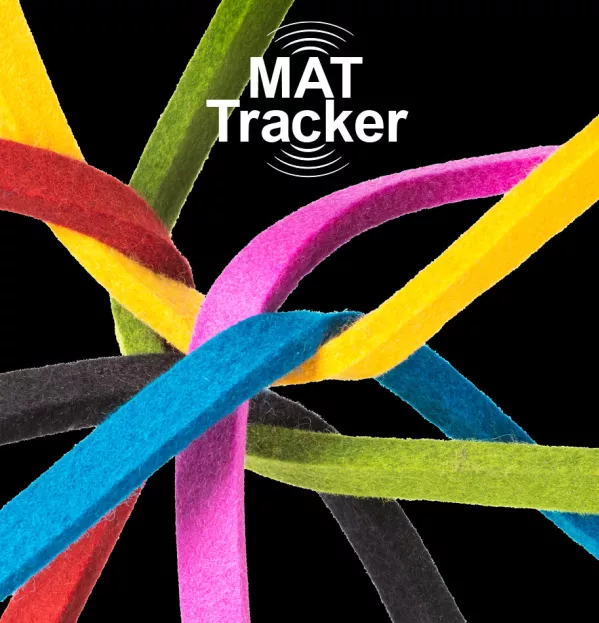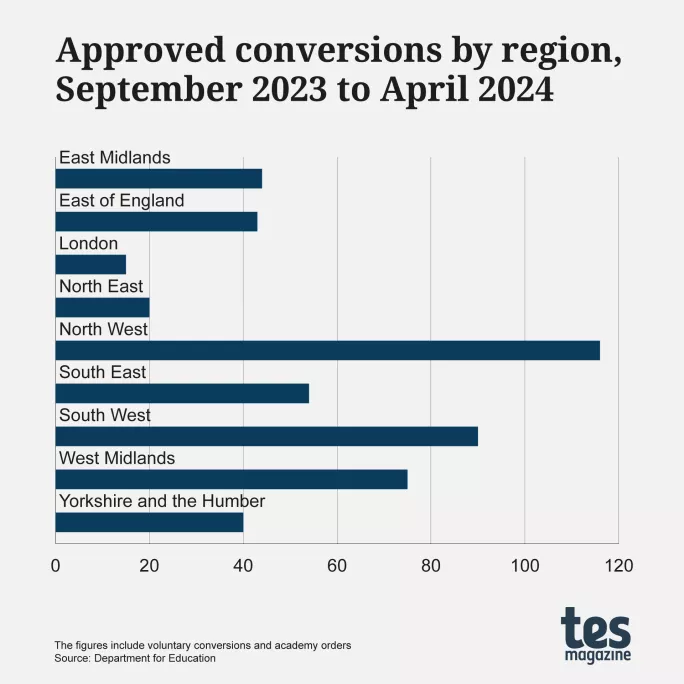MAT growth decisions: key trends from 2023-24

Multi-academy trusts have received mixed messages on the subject of growth in recent years.
The new government’s school standards adviser recently told school leaders that he is “pretty agnostic” about school structures. And education secretary Bridget Phillipson has said that the government will focus on standards, not structures.
In contrast, the previous government initially seemed eager for the MAT system to grow, requiring “coasting” schools to join trusts and publishing plans - now shelved - for all schools to be part of a trust by 2030.
But Ms Phillipson’s predecessor as education secretary, Gillian Keegan, sparked alarm in the sector when she announced that there would be “no push or pull” on academisation.
Despite this, the Department for Education later made a funding change that seemed designed to speed up MAT growth.
Against this shifting backdrop, what is the reality of MAT growth? And does it vary by region?
With the academic year drawing to a close, Tes has analysed all of the regional advisory board decisions that have been published since September - covering the period up to April - to find out.
Here are the major trends in MAT growth during 2023-24.
14 times more primary conversions than secondary
Amid fears about the future of “orphan” primary schools - smaller schools that are not attractive to MATs - 421 primaries have been approved to become academies (including converter and sponsored routes) since September, compared with 31 secondaries.
Some 82 per cent of secondary schools are already academies but the figure for primaries is almost half that - 44 per cent.
Meanwhile, 21 special schools were approved to join MATs, along with six pupil referral units and four sixth forms.

Conversions or academy orders for primary schools were more likely to be approved than those for secondaries.
Some 94 per cent of discussions around primary schools ended in the move being approved or approved with conditions, compared with 84 per cent for secondaries.
Research by FFT Education Datalab suggests that, at the current rate of academisation, all schools will not be part of a MAT until around 2041.
The North West advisory board approved the most academy conversions, including orders, this year (116), while London oversaw just 15.
Regional directors have also approved the dissolution of three MATs this year.
Overall, 30 conversions were approved on condition that a school resource management adviser (SRMA) would be deployed.
The SRMA programme has received mixed feedback over the years, with some leaders complaining about “unrealistic recommendations” being given, including that schools could save money by reducing the size of school dinner portions.
Earlier this year the DfE invited organisations to bid for a contract worth at least £7 million to supply schools with advisers to help manage their resources.
North West is the busiest advisory board
Overall, regional advisory boards discussed 743 potential conversions, academy orders, mergers, single-academy trusts joining MATs, trust changes, dissolutions and new MATs, with 689 such decisions approved.
Other areas discussed by boards include amalgamations, new free schools and “significant changes” - such as to a school’s age range.

The North West discussed the most outcomes related to MAT growth, accounting for 161 decisions, 145 of which were approved.
Less than a third (30 per cent) of state-funded schools in the region were academies as of January 2024, according to school workforce census data, making it the region with the lowest rate of academisation.
In terms of discussing the most outcomes, the North West was closely followed by the South West, where 138 decisions were made and 136 of those were approvals. This is despite the region already having the highest academisation rate (63 per cent).
London discussed just 24 outcomes, with 21 approvals.
New all-primary MATs
The formation of some 23 new MATs was discussed by boards, with all but three approved.
Of the 20 new MATs approved, six were all-primary, while three were all-secondary.
Two consisted of both primary and secondary schools.
- Academy decisions by month: Regional advisory boards
- MAT Tracker: Mapping the country’s multi-academy trusts
- Background: Concern as MAT growth advisory meetings halted
Leora Cruddas, chief executive of the Confederation of School Trusts, said there are “good reasons why setting up a new trust may make sense”, including existing federations collaborating or where there is “not immediate capacity within existing trusts”.
“We would expect to continue to see new trusts being established for some time, as well as the evolution of existing trusts.”
Single-academy trust closures continue
As revealed by Tes earlier this year, the decline of single-academy trusts (SATs) accelerated between January 2023 and January 2024, with the number falling by almost 9 per cent from 1,091 to 994.
Overall, the decline of SATs far outstrips the decline of academy trusts, which have been decreasing steadily over the past four years, by 1 or 2 per cent year-on-year.
And our analysis of advisory board minutes for the academic year through to April reveals that 64 SATs were approved to join MATs, with more than a fifth of these in the North West (13).
South West has the most mergers
Of the 33 mergers approved this academic year so far, 13 of these (39 per cent) were in the South West.
Analysis carried out as part of the Tes MAT Tracker shows that the South West has the largest MATs overall, with the average MAT with its headquarters in the South West consisting of 11 schools.
Mark Blackman, director of education consultancy Leadership Together, said the South West region has “matured really quickly” and is working collaboratively.
He said that leaders in the region “are really keen to engage with the regional director”, and a “place-based approach” is popular.
Mr Blackman added that mergers are a “relatively new thing, so we haven’t really had a chance in the system to see how they work in terms of delivering for children”.
DfE documents published last year set out how the government wanted to see MAT mergers, with reports showing that DfE regional teams had identified a need for SATs or smaller academy trusts to merge or join larger MATs.
Six in 10 rebrokerages are primaries
The regions group approved the trust change (rebrokering) of 72 academies between September and April.
Of those, 44 (61 per cent) were primaries, with 16 secondaries also rebrokered.
Some 32 per cent of these trust changes were in the South West.
The figures likely reflect the fact that there are more than 7,200 primary academies, compared with around 2,600 secondary academies.
North West defers the most decisions
Regional directors can choose to defer a decision if they feel more information is required.
For example, board minutes from the East of England in September 2023 show that the regional director requested further information on school improvement strategy and assurance on governance plans before making a decision on a merger.
Of the 49 growth decisions that were deferred this year, 16 of those (33 per cent) were taken in the North West, followed closely by the East of England (14).
Find our interactive map of England’s multi-academy trusts by clicking here, where you will also find links to all of our MAT Tracker content
You need a Tes subscription to read this article
Subscribe now to read this article and get other subscriber-only content:
- Unlimited access to all Tes magazine content
- Exclusive subscriber-only stories
- Award-winning email newsletters
Already a subscriber? Log in
You need a subscription to read this article
Subscribe now to read this article and get other subscriber-only content, including:
- Unlimited access to all Tes magazine content
- Exclusive subscriber-only stories
- Award-winning email newsletters
topics in this article



